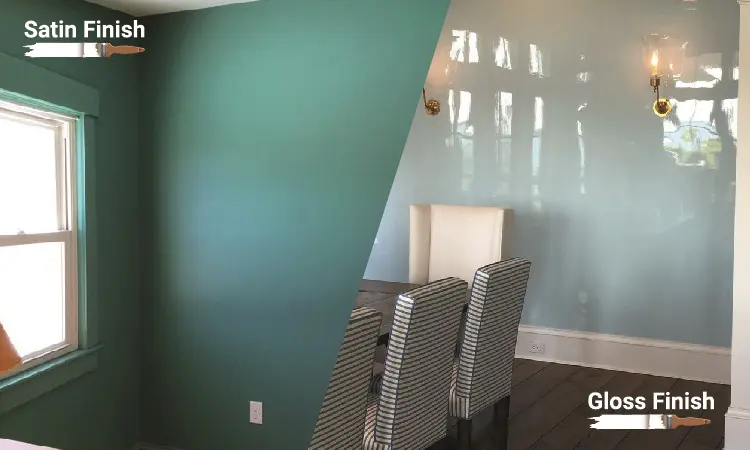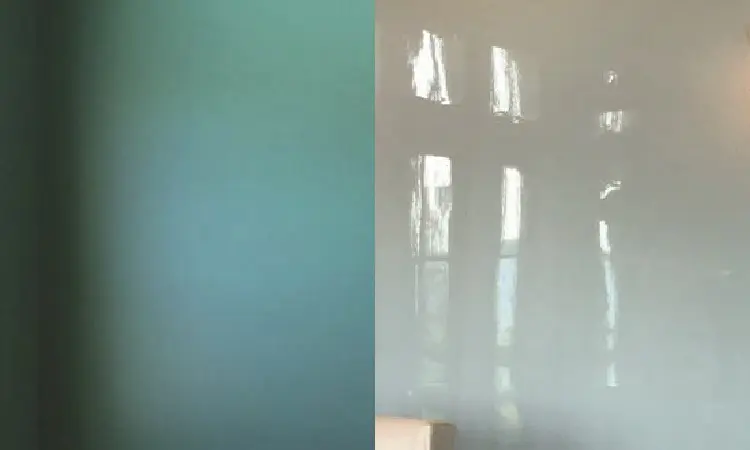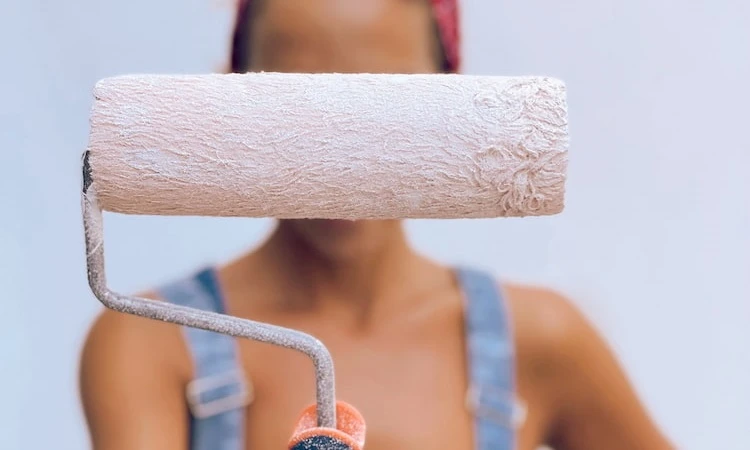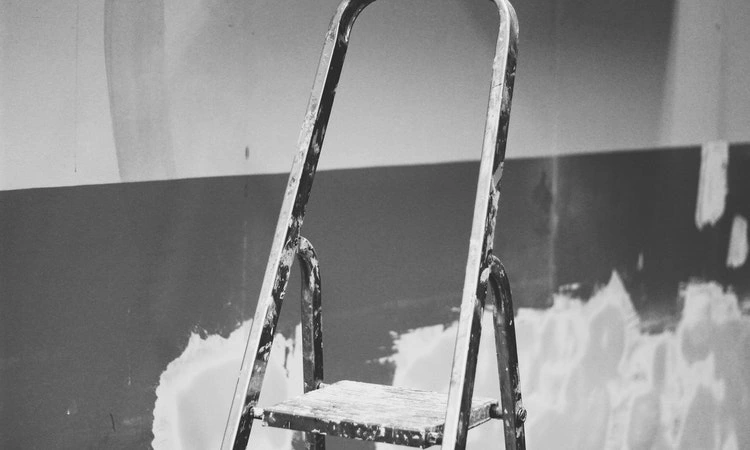If you have ever bought house paint before, you probably learned that it’s often easier said than done. Why?
Because there are what seems like never-ending rows and rows of paint products on store shelves, there are different colors, brands, finishes, etc., and the process of picking out paint can seem daunting.
Speaking of finishes, two particular types, satin and gloss, are what I am here to discuss with you today.
Which one should you use? Satin and gloss finishes have distinct characteristics, and by learning about them, you’ll be able to make the perfect selection for your home improvement projects.
The primary difference between a satin and gloss finish is the sheen, which is what I’m discussing in the next section.
Hence, don’t go away just yet. Instead, stick around and read on to acquire the information you crave.

Does Gloss Or Satin Finish Shine More?
Sheen is a verb that also means shine or cause to shine softly. Both of these solutions shine. Although, satin doesn’t shine quite as much as gloss.
Resources say that satin is more of a matte finish. It reflects light at 26 to 40 percent and is in the middle of the pack regarding shininess.
Meanwhile, gloss finishes are shiny. They reflect between 70 and 90 percent of light.
If you want whatever you’re painting to have a lustrous and reflective finish, gloss is the answer. Of course, as mentioned, satin reflects and shines a little, but the gloss does that even more.
So, if you want walls, trim, doors, window frames, or even cabinets to stand out, a glossy product could be the perfect solution.
Satin vs. Gloss Best Usage Chart
| Project Area | Satin | Gloss |
|---|---|---|
| Bedroom | ✔ | ✖ |
| Family Room | ✔ | ✖ |
| Dining Room | ✔ | ✖ |
| Kids' Room | ✔ | ✖ |
| Living Room | ✔ | ✖ |
| Hallway | ✔ | ✖ |
| Bathroom | ✔ | ✔ |
| Kitchen | ✔ | ✔ |
| Ceiling | ✔ | ✖ |
| Trim | ✔ | ✔ |
| Windows | ✔ | ✔ |
| Doors | ✔ | ✔ |
| Interior Furniture | ✔ | ✖ |
| Cabinets | ✔ | ✔ |
Differences Between Satin And Gloss Finish

Durability
When diving into the differences between satin and gloss finish, you must consider durability.
After all, who wants to paint something only for it to peel a few days, weeks, or months later? Or what if every little thing leaves a scratch behind?
Do you really want to be making touch-ups repeatedly because you chose the wrong paint? Durability is the key to keeping such issues at bay.
In general, glossy finishes are more durable than those of the satin variety. Typically, a surface painted with glossy paint will last around ten years, ensuring it is properly maintained.
Meanwhile, the same can not be said for satin finishes. They tend to remain in tip-top condition for about six years if people are lucky.
Glossy paints take longer to dry than their satin counterparts. They have more resins and other ingredients than them as well.
As such, the particles have more time to cure and solidify, making the paint durable. There is certainly nothing wrong with using satin paint. However, you’ll probably want to consider a glossy option to get the most bang for your buck.
Maintenance
From time to time, painted objects get dirty. For example, do you have kiddos in the house?
If that’s the case, how often have they run through the hallway with mud or something else on their hands, only to get it on the wall, door, or trim?
Or if you don’t have children, how about a pet? When dogs and cats run about throughout the house, everything from walls to painted pieces of furniture can get nasty.
The point is that you’ll probably need to clean whatever you paint on occasion. That will keep things looking fresh and sharp, which everyone in the household is sure to appreciate.
Not to mention, preventative maintenance can extend the life of a paint finish.
Start by reading the label on the paint can if you still have it. There should be directions on it for application and maintenance.
Don’t fret if the data isn’t there, though. I’m not going to leave you hanging. Always begin cleaning with nothing more than a soap and water solution.
Use a sponge to gently wipe the wall, ceiling, or whatever down with soapy water. That may be all that’s needed to maintain your paint finishes.
It is of the utmost importance to avoid using harsh chemicals when cleaning/maintaining satin finishes. That’s because they can sustain damage from harsh household cleaners or degreasers.
Stick to a mild and gentle soap solution to keep your finish intact and looking its best. Moisten and wring out the sponge to make at least two passes over the painted item.
Running it across or over the affected area might not be enough with the diluted cleaning solution.
Finally, it is now time to dry the painted surface. Don’t worry, though. It won’t be too difficult. You do not need to scrub anything with a towel or napkin.
Nor is there any reason to blow on the paint, using nothing more than the air in your lungs. If there is a window in the room, open it.
Let the fresh breeze take care of everything. If there isn’t a window, set up a fan or turn a ceiling fan on in the room. That will get the air circulating and dry the paint in no time.
Price
Consumers across the globe are feeling it. Inflation is up, and they feel like they’re paying more for goods. Of course, each time they go to fill up their gas tanks, they’re feeling it.
Not to mention, buying building materials, including paint, can leave you almost breaking the bank.
Because of the higher sheen and protection, people have always had to pay a bit more for glossy finishes over satin finishes.
That notion still holds true today. Customers will spend a bit more of their hard-earned cash on gloss paint than on satin paint. However, the amount is not unbearable. People can normally purchase a gallon of satin or gloss for under $25.
Coverage
Does your wood siding have imperfections here, there, and everywhere? Or how about the drywall inside your house? Did you do it yourself?
That’s great if you did. It means you’re handy and can keep your home in tip-top shape. Plus, the sheet rock project should have saved you some money.
You’ll save each time you don’t pay someone else to improve your property.
However, I want to go back to the imperfections. Homeowners aren’t professionals who hang siding and drywall each day.
They probably don’t tape and float, caulk, or do anything along those lines either. So, their projects sometimes have flaws.
That’s fine, as it just gives the place character, but some people don’t want to look at issues, which is understandable.
That’s where painting comes in handy. A coat of the right paint can disguise imperfections. It might not make each one disappear altogether, but it can make them easier on the eyes.
Due to satin paint not reflecting light as much, it hides blemishes better than its gloss counterpart. Therefore, if your primary goal is to conceal things, it is in your best interest to buy a product with a satin finish.
Consistency
Gloss and satin finish paints can be applied by brush, roller, or sprayer. The rolling method will be the focus here.
Satin paint usually has a thinner consistency than gloss paint. When beginners roll the paint onto surfaces, they are often left with streaks if they aren’t careful.
Use long, smooth strokes of the roller to avoid this, or if you’d rather, why not simply choose gloss paint?
Of course, the project will need to be something appropriate for gloss paint. So, refer to the usage chart to see if yours is a suitable candidate.
Providing that everything is A-okay in this department, pour your chosen gloss paint into a tray.
Next, coat the roller and roll it back and forth on the tray to remove excess paint. Touch the covered roller to the surface that needs paint.
Once again, using long, smooth strokes, apply the gloss paint to the wall. Because the paint is a little thicker than satin paint, it should go on pretty evenly and cover well.
Don’t worry too much about any missing spots. The second coat you apply will take care of the holidays.
Can You Paint Satin Over Gloss?

You can certainly paint satin over gloss. After all, almost any type of paint can be used to cover another type.
However, that doesn’t mean you’ll end up with the results you were hoping for, especially if the gloss is oil-based. As a general rule of thumb, it is always oil over water and not the other way around.
This may not sound like it should be all that vital, but I’ll tell you why it is.
Sometimes, people want to paint over cabinets, doors or trim previously painted with oil-based paints.
The only problem is that they sometimes fail to consult with anyone and purchase a water-based product to do the deed.
Then, the two substances don’t mesh, and only a few short days or weeks later, the water-based paint is bubbling and peeling off.
Can You Paint Gloss Over Satin?
Painting gloss over satin is typically no problem at all. The paint usually goes on smoothly and cleanly, just as the painter would expect it to.
The satin serves as a primer, and the gloss finish adheres to it, creating a robust coating. Put the first coat on and see how it looks.
There’s a good chance you’ll need a second coat, so don’t get down if the paint isn’t as shiny as you were hoping.
It really depends on the thickness of the paint, though. The first coating will need to dry for approximately four to six hours.
After that amount of time has expired, it will then be time to apply the second coat of gloss paint, providing that it’s needed.
Once you’re finished and the paint cures, you should have the desired glossy finish.
But hopefully, you aren’t in too big a hurry. Research suggests that it takes between 16 and 24 hours for oil-based gloss paints to cure.
Meanwhile, it’s an entirely different ballgame as far as indoor projects are concerned. That’s because it takes oil-based gloss paint seven days to cure inside a structure.
Gloss vs. Satin: Moisture And Water Resistance
Satin paint offers decent moisture resistance. Hence, it will protect the wood, drywall, and other building materials you coat from water to a certain extent.
Thus, it doesn’t matter what you paint, a bathroom, a kitchen, or even some interior furniture; they will be shielded from moisture.
But if you want the most protection, paint with a gloss finish might be a better fit. That’s because when cured, whatever you paint, will almost be waterproof.
The moisture resistance of a satin finish will be better in the beginning. Then, typically after a few months, that resistance will begin to deplete. As for gloss finishes, they usually remain water-resistant for several years.
Will Satin Or Gloss Get Dusty The Quickest?
There are numerous factors to consider when determining how the dust will attract your paint. For instance, do you live on a dirt road, where dust and dirt particles regularly fly in the air when cars drive by?
Those could easily find their way inside your home and get all over everything. Regardless of the circumstances, a gloss finish generally doesn’t pick up as much dust as a satin finish. Henceforth, it’ll be easier to keep clean.
In addition, when satin or gloss paints are used on wood floors, which I’ll touch on later, they show every little spill and speck of dirt.
Therefore, you should have no trouble seeing messes to clean them. However, that could be a con as well because who really wants to see stuff on their floor all the time?
Painting Satin vs. Gloss: Surface Preparation
This may sound like a no-brainer, but it can be tempting just to paint right over dust, grime, and even mildew. If it’s out of sight, it’s out of mind, right?
However, if a person doesn’t properly clean the wall, furniture, or whatever they’re painting, out of sight might not be where the issues stay.
For one, the paint, satin or gloss, may not remain stuck to the surface because of the contaminant. Rather, it will peel, and whatever you left in place will be staring you in the face.
So, if you have a pressure washer, use it to spray siding, trim, and other items located outside. Then, you’ll need to let the area dry completely before painting.
Is your project indoors? For example, are you painting walls, the ceiling, and everything else in a bathroom?
Or how about the cabinets and trim in the kitchen? Obviously, you won’t be bringing the pressure washer into these areas to clean them.
Instead, use a sponge and a diluted soapy water solution to wipe things down. Afterward, allow the cleaned spots to dry and apply your paint.
Taking these and other measures to clean before painting ensures your gloss or satin finish comes out looking its best.
Can A Floor Be Painted With A Satin Or Gloss Finish?
Looking at the usage chart, you can see that floors are nowhere on it. However, just because satin or gloss finishes aren’t recommended for floors doesn’t mean they won’t do the trick.
Wood floors can be painted, but you should do yourself a favor before jumping right into the project.
If you have an extra piece of flooring, perhaps in the garage or a closet somewhere, now would be a great time to get it out.
Apply the paint to this piece to see how it looks. Then, you’ll know if the visual appearance is acceptable before going through all the hard work of moving furniture and painting an entire floor.
If you do not have an additional piece of floor anywhere, at the very least, test the paint in an inconspicuous area first.
If you don’t like it, you can always hide the spot beneath a rug, bookshelf, or something else.
Now, the question is, “What type of paint should you use on such a home improvement project?”. Something with a satin or gloss finish will work.
The gloss is shiny, which some people like and others don’t. Those that don’t appreciate the appearance can paint their wood floor with satin.
It won’t be nearly as bright in the room because the finish won’t be as reflective as that of gloss paint.
A Few Last Words
Now that you’re armed with this information, you should be able to decide whether a satin or gloss finish is appropriate for your project.
Satin is right under certain circumstances, while gloss is better for other situations.
So make sure you choose correctly by using what you’ve learned here today.
You’ll be happy that you did when the finish you decide on surpasses your expectations in every way.


